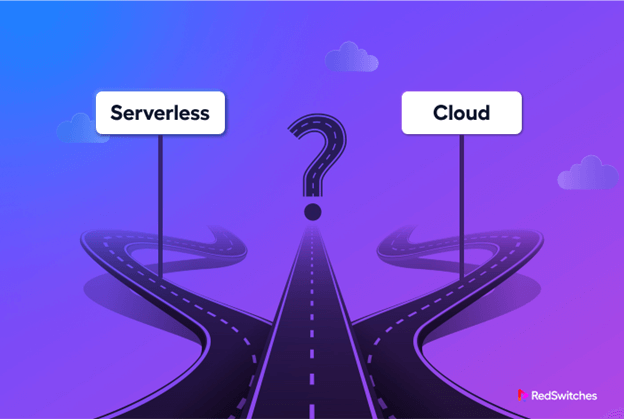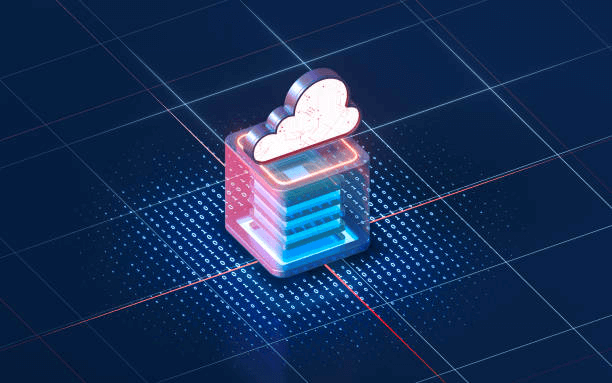Did you know the serverless computing market will reach $17.5 billion by 2026, while cloud computing will reach $832.1 billion by 2025? In today’s digital age, businesses must choose a suitable computing model for efficiency, scalability, and security. Complete serverless computing vs. cloud computing comparison can help businesses make informed decisions.
Serverless computing offers a cost-effective, flexible, and scalable approach to application development and deployment.
In contrast, cloud computing provides a broader range of services for businesses seeking to manage and store data, but how do you choose between these options?
At RedSwitches, a leading cloud hosting company, we understand the importance of selecting a suitable computing model for your business needs. Our team of experts, through this article, will help you evaluate the pros and cons of cloud computing vs. serverless computing and help you make an informed decision that meets your specific requirements. Keep reading to learn more!
Table of Content
- What is Cloud Computing?
- What is Serverless Computing?
- Difference Between Serverless Computing vs. Cloud Computing
- Why Should Business Owners & Startups Use Serverless Architecture?
- Key Takeaways
- FAQs
What is Cloud Computing?
Cloud computing refers to using remote servers to store, manage, and process data over the Internet. It offers businesses a range of benefits, including increased flexibility, scalability, and cost-effectiveness.
When selecting a suitable computing model for your business, it’s essential to understand the differences between serverless computing and cloud computing. However, serverless computing is ideal for companies with varying workloads, while cloud computing suits those seeking a more comprehensive range of services.
Embracing the guidance of cloud experts like RedSwitches offers top-notch cloud hosting services for businesses. They aid in evaluating computing models that align with the goals of large and small businesses.
Cloud experts help businesses lacking in-house expertise make informed decisions. They help select the suitable cloud computing model based on unique requirements, optimizing performance and efficiency and minimizing costs and risks.
Also Read: 6 Key Differences: Cloud vs On Premise Computing Revealed!
What is Serverless Computing?
Serverless computing is also known as Function-as-a-Service (FaaS). It is a cloud computing model that helps developers create and run applications without needing server infrastructure management. In serverless computing, the cloud provider addresses the server infrastructure and charges for the number of resources the application uses. This makes it a cost-effective solution for businesses with fluctuating workloads.
When talking about traditional cloud computing vs. serverless computing, serverless computing offers more flexibility, scalability, and faster time-to-market for applications. However, it may only be suitable for some applications and workloads, such as those with long-running processes or consistent usage patterns.
RedSwitches, a reputed cloud hosting company for cloud security, provides serverless computing and cloud computing solutions to businesses of all sizes. Whether your business requires the flexibility and cost-effectiveness of serverless computing or the control and customization of traditional cloud computing, RedSwitches can help you select the right computing solution for your unique business needs.
Difference Between Serverless Computing vs. Cloud Computing
| Types of Computing | Aspects | Pros | Cons |
|
Serverless Computing |
Architecture | -Reduced infrastructure management overheads free up developer time for more productive tasks.
-Easy integrations with other cloud services facilitate agile development and deployment. |
– Reduced infrastructure management can result in less control over security, governance, and compliance.
– Easy integrations with other cloud services can create dependencies and vendor lock-in, limiting flexibility and portability. |
| Billing | -Serverless Computing’s pay-per-use model allows for cost savings and efficient resource utilization.
-Granular billing enables accurate tracking of usage and cost allocation. |
-Cost can be unpredictable and difficult to estimate for complex applications.
-It may be more expensive for high-traffic or long-running functions. |
|
| Performance | -Rapid scaling and instant availability ensure high performance even under heavy loads.
-Serverless architecture allows for faster development cycles and time-to-market. |
-Cold starts may cause latency and slow down function execution.
-Resource allocation and availability may be affected by unpredictable spikes in usage. |
|
| Latency | -Serverless computing offers a distributed architecture, reducing the risk of single points of failure.
-Highly scalable, serverless computing can handle large workloads without sacrificing performance. |
Debugging and monitoring can be challenging in a distributed serverless environment.
-A lack of predictability in billing may make it challenging to optimize for latency. |
|
| Deployment | -Serverless computing offers faster and easier deployment of applications.
-With serverless computing, developers can deploy code without worrying about infrastructure management. |
-Serverless computing can be challenging for deploying complex applications.
-Deployment in a serverless architecture requires strict adherence to strict limits on resources and execution time. |
|
| Scaling | -Serverless computing can scale automatically and instantaneously without manual intervention
-The pay-per-use billing model ensures that users only pay for their resources, making it a cost-effective solution for scalable applications. |
-Cloud providers may impose scaling limitations, making it difficult to scale beyond a certain point.
-Testing and debugging large-scale applications in a serverless environment can be challenging, requiring specialized tools and expertise. |
|
|
Cloud Computing |
Architecture | -Multi-tenant architecture enables cost savings through resource sharing.
-A wide range of cloud services provides flexibility and customization options for architecture design. |
Potential security risks due to the shared nature of cloud infrastructure.
-Lack of control over the underlying infrastructure may limit customization options. |
| Billing | -Cloud providers typically offer detailed usage reports and monitoring tools, making managing and tracking expenses more manageable.
-Cloud providers offer various pricing plans and discounts, allowing customers to choose what works best |
-Cost optimization can be complex, requiring specialized skills and tools to manage expenses effectively.
-Hidden fees, such as data transfer costs, can quickly add up. |
|
| Performance | Access to powerful computing resources such as GPUs and TPUs can significantly improve application performance.
-Cloud-based storage solutions can provide fast access to data from anywhere worldwide. |
Cloud providers may prioritize cost savings over performance, resulting in lower performance levels for particular services or applications.
-Cloud providers may offer limited customization options, which can affect the performance of some businesses. |
|
| Latency | Availability of edge computing services to minimize latency and improve response times.
-Ability to quickly provision and de-provision computing resources as needed. |
Limited control over the underlying network infrastructure can make it challenging to optimize for low latency.
-The cloud provider’s location can significantly impact latency, leading to unpredictable results. |
|
| Deployment | -Flexible deployment options, including hybrid and multi-cloud, provide a range of choices for organizations.
-Rapid deployment of new applications or updates across multiple locations. |
-Managing and coordinating deployments across multiple regions or cloud providers can be challenging.
-Dependence on internet connectivity and network performance may cause deployment delays and issues. |
|
| Scaling | Cloud-based load balancing distributes traffic evenly across multiple servers, improving overall scalability.
-Cloud infrastructure allows for elastic scaling, enabling quick and easy adjustment of resources as needed. |
Scaling in the cloud can be complex, requiring careful planning and management to avoid issues with resource allocation.
-Over-provisioning resources can lead to unnecessary costs, reducing the cost-effectiveness of cloud computing. |
Why Should Business Owners & Startups Use Serverless Architecture?
Serverless architecture is ideal for businesses and startups that require flexibility, scalability, and cost-effectiveness. Companies can benefit from serverless computing, which offers a pay-as-you-go model. This enables them to scale their resources up or down as needed without the expense and hassle of maintaining traditional infrastructure. With serverless computing, companies only pay for what they use, which can lead to cost savings and improved flexibility. This frees up valuable resources for other business-critical tasks, making serverless architecture an attractive option for companies with limited IT resources.
Moreover, serverless computing allows developers to focus on developing applications rather than infrastructure management. This makes it an excellent option for startups and small businesses with limited development resources. Serverless computing also enables enterprises to deploy applications faster, gaining a competitive advantage in the market.
Serverless architecture has benefits for businesses. It saves costs, improves efficiency, and stays competitive. Despite limitations, it’s an attractive option.
Key Takeaways
- Cloud computing vs. serverless computing are necessary technologies businesses can leverage for their computing needs.
- Cloud computing vs. serverless computing provides more control over infrastructure and configuration, making it a good choice for businesses with more complex needs and IT teams who want greater control.
- Both cloud computing and serverless computing offer cost-effective options for businesses looking to access enterprise-grade technology without significant upfront investments.
- When selecting a suitable computing model for their business, companies must weigh each difference between cloud computing and serverless computing, such as control, scalability, and cost-effectiveness.
In conclusion, selecting the right computing technology for your business is crucial to its success. When looking at serverless computing vs. cloud computing, each technology has its benefits and drawbacks. RedSwitches, a reputable cloud hosting company, provides businesses with secure cloud solutions to meet their computing needs. With careful consideration of specific business needs, companies can select the best computing technology.
Also, It’s essential to regularly evaluate and update your computing technology as business needs evolve.
FAQs
- Is serverless suitable for startups?
Serverless computing is an excellent option for startups looking to reduce costs and increase scalability. With serverless computing, businesses only pay for the computing resources they need, making it an affordable option for startups. However, weighing the pros and cons of serverless computing vs cloud computing is crucial to determine which choice is right for your business.
- Is serverless computing the same as PAAS?
Serverless computing and PaaS are not the same things, but they share similarities. PaaS is a cloud service that lets developers build and deploy apps without managing infrastructure. On the other hand, serverless computing takes PaaS a step further by abstracting the entire infrastructure layer. This enables developers to focus solely on the code.
Consider serverless computing vs. cloud computing and others like PaaS. Evaluating the differences is essential when choosing a computing model for your business.
- When to choose serverless computing vs. cloud computing?
Serverless computing is an excellent choice for running code on-demand without provisioning or managing servers. It’s a cost-effective and scalable option that lets you focus on building your application rather than infrastructure management. You should choose serverless if you have a variable workload, need to handle traffic bursts, or want to reduce your infrastructure costs.
- When to avoid serverless computing vs. cloud computing?
Serverless computing can be an excellent option for many businesses, but sometimes it may not be the best choice. For example, serverless computing may not be the right fit if an application requires consistent and predictable performance. Consider a more traditional cloud computing approach if you have an application requiring high control over the underlying infrastructure. Ultimately, using serverless or cloud computing depends on your business needs and goals.



